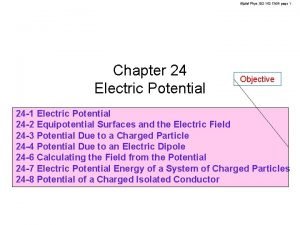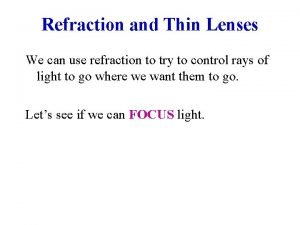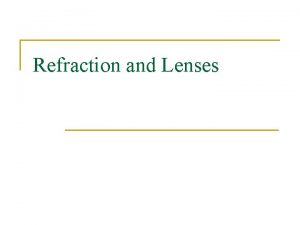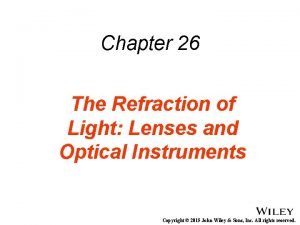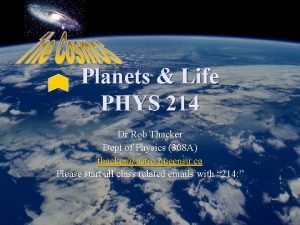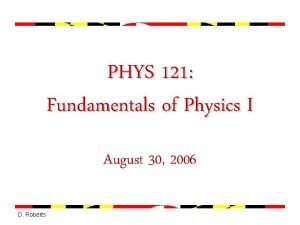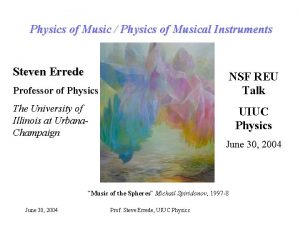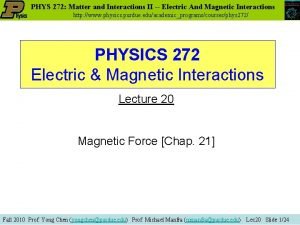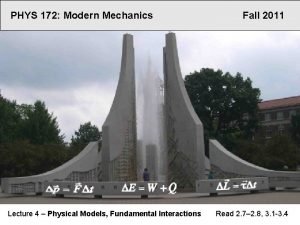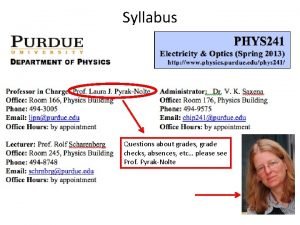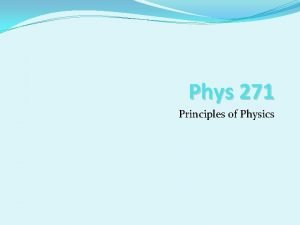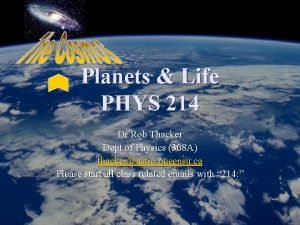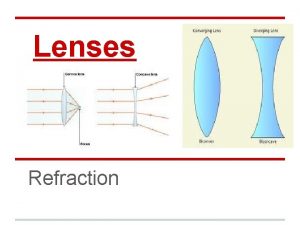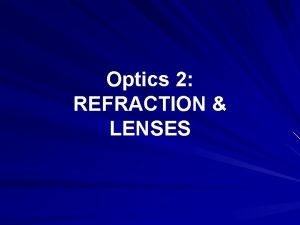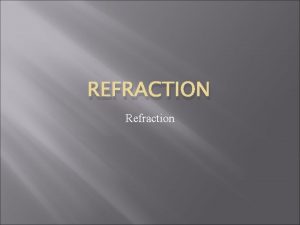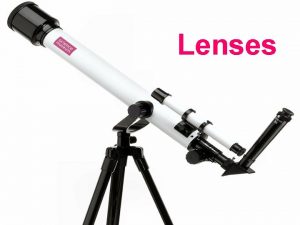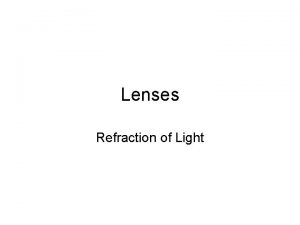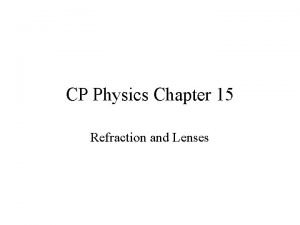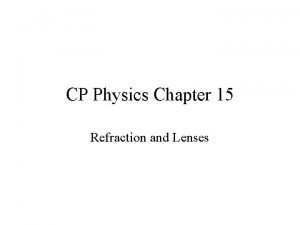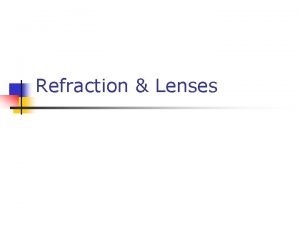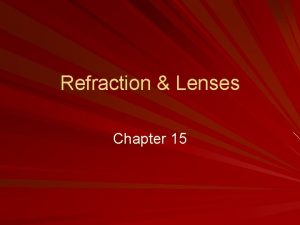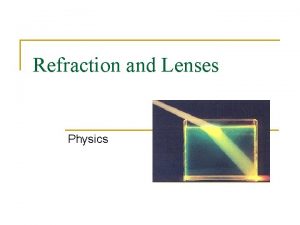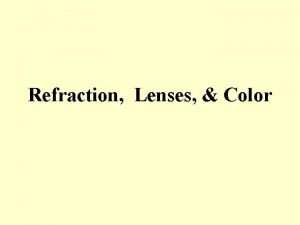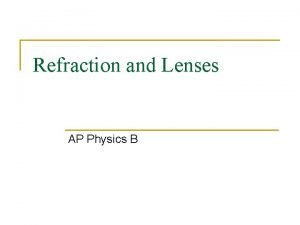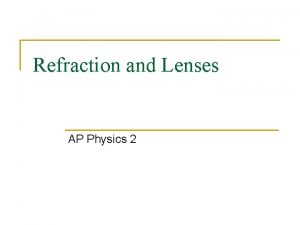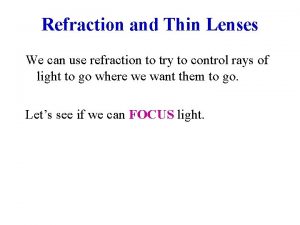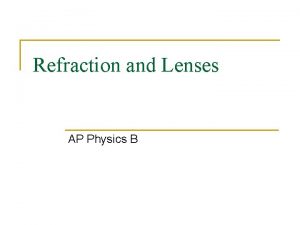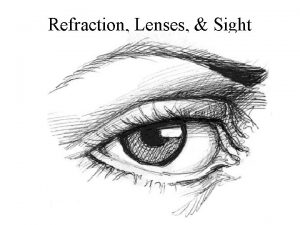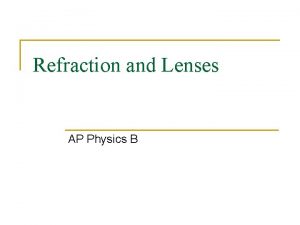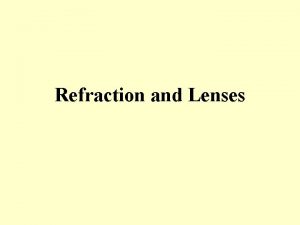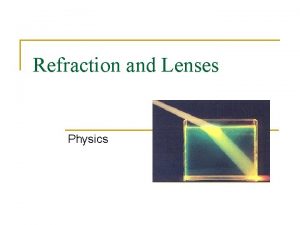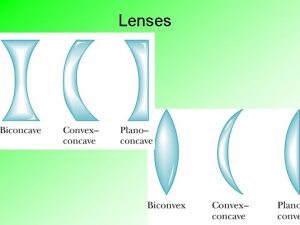Phys 102 Lecture 19 Refraction lenses 1 Today
























- Slides: 24

Phys 102 – Lecture 19 Refraction & lenses 1

Today we will. . . • Review refraction Snell’s law • Learn applications of refraction Total internal reflection Converging & diverging lenses • Learn how lenses produce images Ray diagrams – principal rays Lens & magnification equations Phys. 102, Lecture 19, Slide 2

Review: Snell’s Law Light bends when traveling into material with different n If n 1 > n 2 then θ 2 > θ 1 refracted θ 2 θr θ 1 reflected n 2 Light bends away from normal as it goes into a medium with lower n n 1 > n 2 incident Phys. 102, Lecture 19, Slide 3

Total internal reflection From Snell’s law, if n 1 > n 2 then θ 2 > θ 1 So, θ 2 = 90° n 2 n 1 > n 2 θr Light incident at critical angle θ 1= θc refracts || to surface (θ 2 = 90°) Light incident at angle θ 1> θc will only have reflection (θ 1 = θr)! θ 1 = θc Phys. 102, Lecture 19, Slide 4

Calculation: underwater view Explain why the diver sees a circle of light from outside surrounded by darkness nair = 1 nwater = 1. 33 θi θc Phys. 102, Lecture 19, Slide 5

ACT: Check. Point 1. 1 Can the person standing on the edge of the pool be prevented from seeing the light by total internal reflection? A. Yes B. No Phys. 102, Lecture 19, Slide 6

Fiber Optics Optical fibers consist of “core” surrounded by “cladding” with ncladding < ncore. Light hits core-cladding interface at θi > θc, undergoes total internal reflection and stays in the fiber. θi > θc Core Cladding • Telecommunication • Arthroscopy • Laser surgery Only works if ncladding < ncore DEMO Phys. 102, Lecture 19, Slide 7

Converging lens Lenses use refraction and curved surface(s) to bend light in useful ways If n 1 > n 2 then θ 2 > θ 1 θ 2 f p. a. DEMO “Focal length” Converging lens – rays || to p. a. refract through focal point f after lens Phys. 102, Lecture 19, Slide 8

Check. Point 2. 1 A beacon in a lighthouse produces a parallel beam of light. The beacon consists of a bulb and a converging lens. Where should the bulb be placed? p. a. A. At f B. Inside f p. a. f f f C. Outside f Phys. 102, Lecture 19, Slide 9

Diverging lens Lenses use refraction and curved surface(s) to bend light in useful ways If n 1 > n 2 then θ 2 > θ 1 θ 2 p. a. f DEMO Diverging lens – rays || to p. a. reflect as if they originated from focal point f before lens Phys. 102, Lecture 19, Slide 10

Converging & diverging lenses Converging lens: Rays parallel to p. a. converge on focal point after lens Converging = thick in the middle = “Planoconvex” Diverging lens: “Double convex” = Rays parallel to p. a. diverge as if originating from focal point before lens Diverging = thin in the middle = “Planoconcave” “Concaveconvex” = “Double concave” “Convexconcave” Phys. 102, Lecture 19, Slide 11

ACT: Lens geometry The following lenses are all made from the same material but have different geometry Which lens has the shortest (positive) focal length? A. B. C. D. Phys. 102, Lecture 19, Slide 12

ACT: Check. Point 3. 1 A glass converging lens placed in air has focal length f. nglass nnwater 1. 33 air = =1. 0 Now the lens is placed in water. Its focal length: A. Stays the same B. Increases C. Decreases Phys. 102, Lecture 19, Slide 13

Images & lenses Like mirrors, lenses produce images of objects Key approaches: • Ray diagrams • Thin lens & magnification equations Phys. 102, Lecture 19, Slide 14

Principal rays – converging lens Ray from object traveling: 1) parallel to principal axis, refracts through f 2) through f, refracts parallel to principal axis 3) through C, travels straight Object f f 2 Image is: Real (light rays cross) Inverted (opposite direction as object) Reduced (smaller than object) 3 1 Phys. 102, Lecture 19, Slide 15

Principal rays – diverging lens Ray from object traveling: 1) parallel to principal axis, refracts through f 2) through f, refracts parallel to principal axis 3) through C, travels straight 1 2 Object Image is: f Image Virtual (light rays don’t really cross) Upright (same direction as object) Reduced (smaller than object) f 3 Phys. 102, Lecture 19, Slide 16

ACT: Check. Point 4. 1 A converging lens produces a real image onto a screen. A piece of black tape is then placed over the upper half of the lens. Object f f Image Which of the following is true: A. Only the lower half of the object will show B. Only the upper half of the object will show C. The whole object will still show Phys. 102, Lecture 19, Slide 17

Thin lens & magnification equations Magnification Image Object f So, f Thin lens equation Same as mirror equations! Phys. 102, Lecture 19, Slide 18

Distance & magnification conventions Object Image ho di f f do hi • do = distance object is from lens: • ho = height of object: • di = distance image is from lens: • hi = height of image: • f = focal length lens: • |m| = magnification: > 0: object before lens < 0: object after lens > 0: real image (after lens) < 0: virtual image (before lens) > 0: converging lens < 0: diverging lens > 0: always > 0: image is upright < 0: image is inverted Note similarities to mirror conventions < 1: image is reduced > 1: image is enlarged Phys. 102, Lecture 19, Slide 19

3 cases for concave mirrors Object is: Past 2 f: 2 f < do Image is: Inverted: hi < 0 Reduced: m < 1 Real: di > 0 Between 2 f & f: f < do < 2 f Object Inverted: hi < 0 Image 2 f f f Object Enlarged: m > 1 Image f f f Object f Real: di > 0 2 f Image Inside f: do < f Upright: hi > 0 Enlarged: m > 1 Virtual: di < 0 DEMO Phys. 102, Lecture 19, Slide 20

ACT: Converging Lens A candle is placed in front of a converging lens. The lens produces a well-focused image of the flame on a screen a distance di away. f p. a. do di f Screen If the candle is moved farther away from the lens, how should the screen be adjusted to keep a well-focused image? A. Closer to lens B. Further from lens C. At the same place Phys. 102, Lecture 19, Slide 21

Calculation: diverging lens A 6 -cm tall candle is placed 12 cm in front of a diverging lens with a focal length f = – 6 cm. Determine the image location, size, and whether it is upright or inverted p. a. f f 4 cm Diagram should agree! Phys. 102, Lecture 19, Slide 22

ACT: Diverging Lenses Where in front of a diverging lens should you place an object so the image is real? p. a. f f A. Closer to lens B. Further from lens C. Diverging lens can’t create real image Phys. 102, Lecture 19, Slide 23

Summary of today’s lecture • Total internal reflection • Lenses – principal rays Parallel to p. a. –> refracts through f Through f -> refracts parallel to p. a. Through C -> straight through • Thin lens & magnification equations Numerical answer consistent with ray diagram Phys. 102, Lecture 18, Slide 24
 Aljalal phys 102
Aljalal phys 102 Uiuc physics 102
Uiuc physics 102 Aljalal phys 102
Aljalal phys 102 Purdue physics 241
Purdue physics 241 What kind of shape is this?
What kind of shape is this? Refraction in lenses
Refraction in lenses Refraction of light in lenses
Refraction of light in lenses 01:640:244 lecture notes - lecture 15: plat, idah, farad
01:640:244 lecture notes - lecture 15: plat, idah, farad Today there is class
Today there is class Today's lesson or today lesson
Today's lesson or today lesson Meeting objective
Meeting objective Characteristic of fingerprint
Characteristic of fingerprint For todays meeting
For todays meeting Today's lesson or today lesson
Today's lesson or today lesson Subtle
Subtle Physics 101 uiuc
Physics 101 uiuc Phys 121 umd
Phys 121 umd Phys 398 uiuc
Phys 398 uiuc Phys 272 purdue
Phys 272 purdue Iterative prediction of motion
Iterative prediction of motion Purdue phys 241
Purdue phys 241 Phys 271
Phys 271 Single slit envelope
Single slit envelope Tsms phys ed
Tsms phys ed Phys 214
Phys 214


